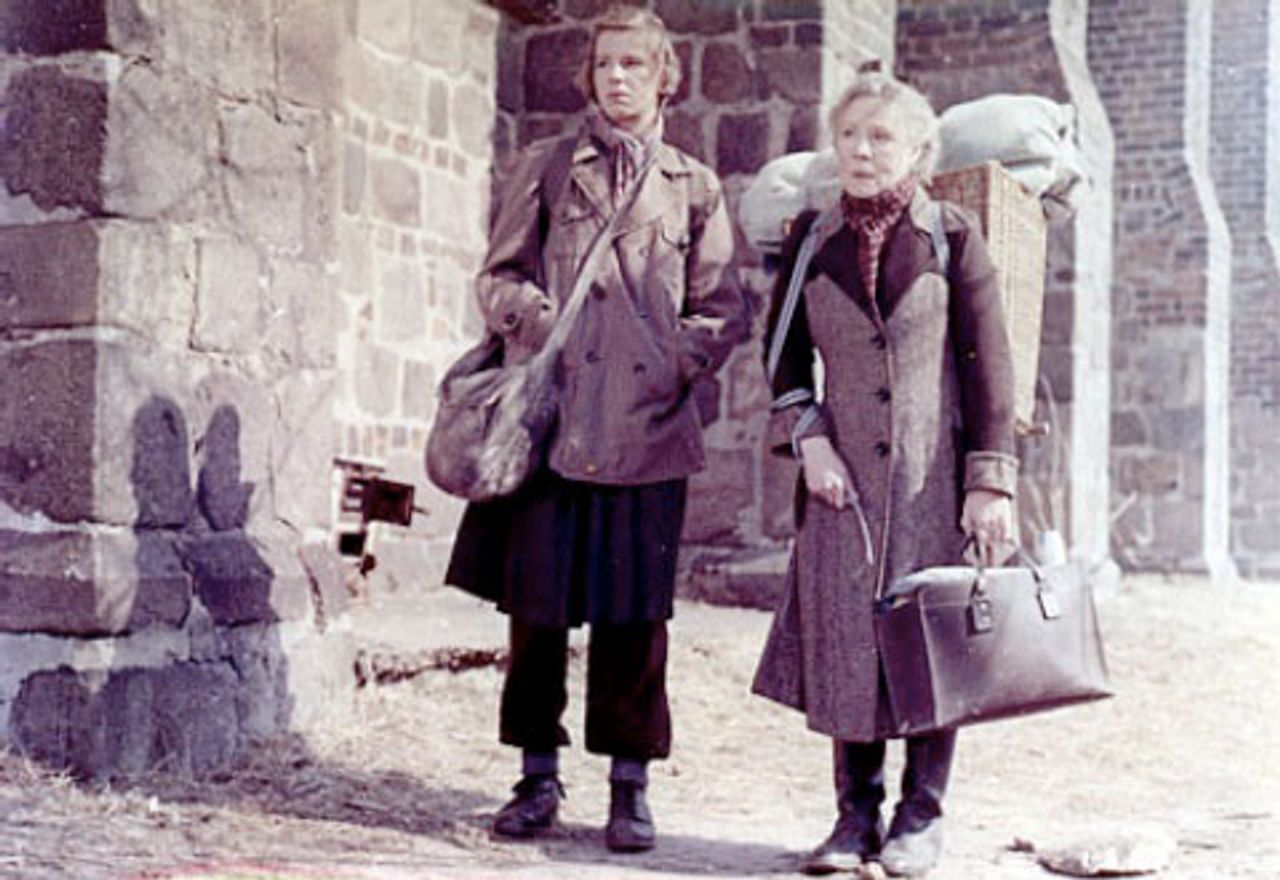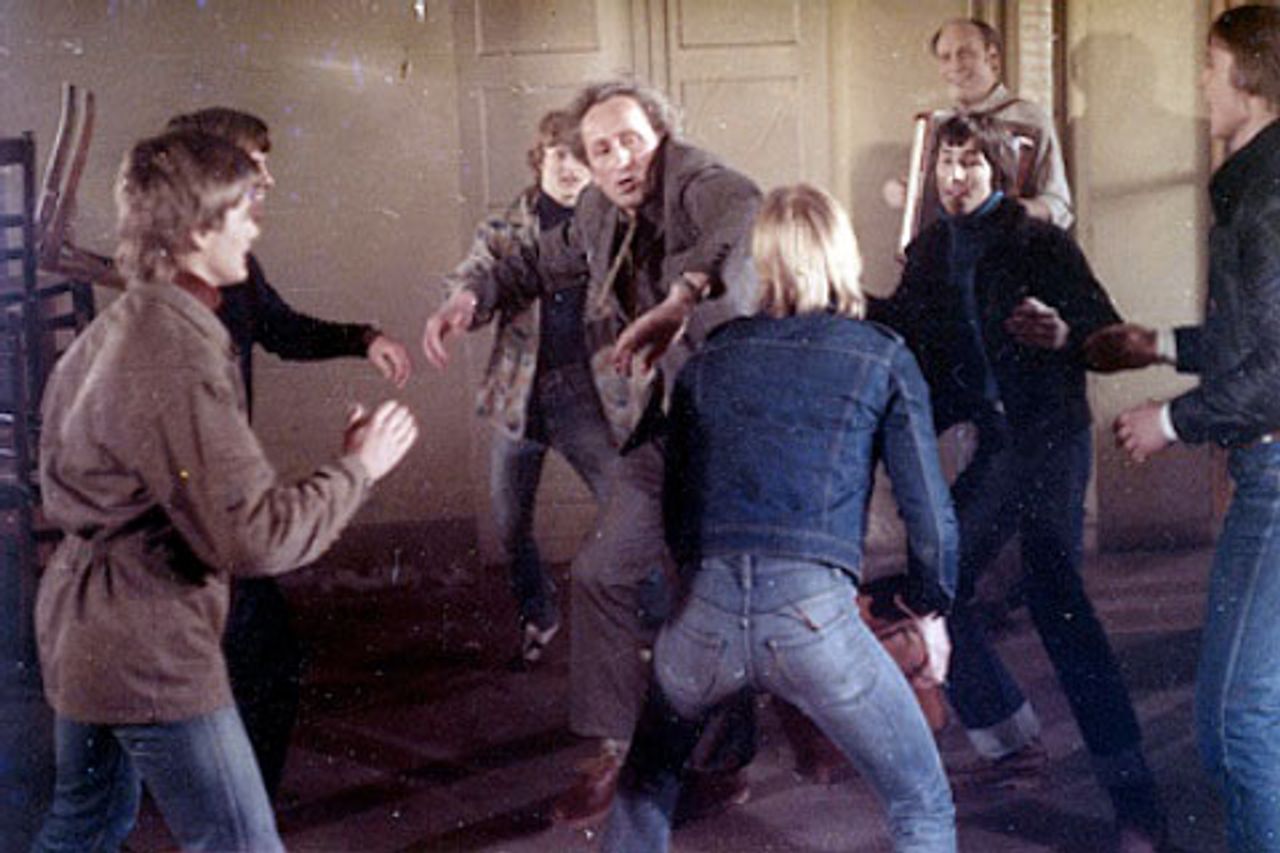The Berlin film festival’s series of special feature films commemorating the fall of the Berlin Wall twenty years ago, “Goodbye to Winter: Cinematic portents of the collapse of Stalinism,” featured Rainer Simon’s Jadup and Boel (1980), the last film from the former Stalinist German Democratic Republic (GDR), i.e., East Germany, to be banned.
 Jadup and Boel
Jadup and BoelIn Simon’s film, an old Marxist pamphlet, found under the ruins of an old house that collapses at the very moment a new department store is being officially opened, awakens bad memories of the period immediately following the Second World War. It was at that time that a young girl, Boel, having arrived in a German town with her mother from Poland, was raped and then disappeared without a trace. The mother has remained an outsider to the community and earns her living burning the town’s rubbish.
A rumour now circulates that Mayor Jadup had something to do with the affair and it reaches the district council of the local Stalinist Socialist Unity Party (SED). But the council has no intention of investigating the matter because it is taken for granted that Jadup could not have had anything to do with the episode. The image of the party is now at issue, just as it was in the past, when the new and eager party member Jadup ruthlessly—but without success—interrogated Boel to find out who the rapist was. It was rumoured in the town that it had been a Soviet soldier. Jadup had not realised how deeply he hurt the girl who in fact loved him. Today he knows that: “Whether or not she’s still alive, we killed her back then with all our questions.”
Unger, a local historian, broods over whether the town’s history began 800 years ago or only after the end of the Second World War. A club of young historians, researching the contribution of their parents to the building of socialism, has no idea. How does one uncover the truth? They have no one to guide them. They have learnt to deal only with empty phrases and outdated rituals.
Eva’s gushing composition about her wonderful parents and their numerous social activities and awards appears in the press and is pinned on the school news bulletin board. When Unger’s daughter Edith makes fun of it, Max, as club spokesman, subjects her to interrogation in the same way Jadup did with Boel. Jadup is horrified to see how indelibly the behaviour of the older generation is stamped upon the new generation.
Finally, Jadup breaks his silence and tells Max about Boel. The film’s hopes for a humane GDR rest on Max and Edith, who, in their straightforward, honest manner, remind Jadup of Boel. During a state ceremony, celebrating the young people of the GDR, Jadup appeals to their sense of honesty and to the youth of the future, who will question all things critically. To drive home the point, he refers to the model set by Lenin, asserting that only in this way can the revolution make progress.
Jadup and Boel lacks confidence in its own arguments. Continual gaps in the narrative and the obvious reworking of scenes—due to cuts and other requirements made by state censors—do nothing to alleviate the film’s prevailing mood of gloom, which leaves the impression that the problems treated are not actually soluble.
The final editing of the film was brought to a halt against the background of strikes and the emergence of the Solidarnosc trade union in Poland in 1980-81. The Stalinist SED was in a state of panic at the prospect of these events spilling over into the GDR. Although the film’s premiere was due to take place in 1981, a letter to the editor of a newspaper, obviously initiated by state agents, sought to have the release date postponed. When tensions within the Stalinist regime increased in 1983, the film was finally banned. The director declared in his book Faraway Country in 2005: “The reason given for the ban was the mounting threat to socialism.”
In the climate of glasnost and perestroika in 1988, the film was shown in selected cinemas and was greeted with much acclaim. The public shared its hope—though a vague one—for a reform of “GDR socialism.” While no one in the GDR spoke at the time of a reintroduction of capitalist private industry, the character of Gorbachev’s reforms in the Soviet Union was becoming increasingly obvious. Simon wrote about the climate of the time in the Soviet capital and the displeasure with which his film was received: “Jadup and Boel came much too late for the Moscow film public. This Jadup was a spokesman for socialist ideals! ... It was a film in which Lenin was quoted.”
There is an eerie scene at the end of the film. Directly after Jadup’s speech, Edith’s father—who once again has drunk too much—is attacked by some young people in a corridor. They push him around, snatch his bag and pages of his recently begun history of the town fly into the air. One of Boel’s suspected rapists from long ago laughingly accompanies the whole thing on his accordion, while Jadup rushes to the aid of the stricken man. Do the careerists win the day? Simon writes that he himself would have been unable to give such a speech as Jadup’s at that point in the history of the GDR.
 Jadup and Boel
Jadup and BoelIt can certainly be said that Jadup and Boel presents us with the director’s quintessential experiences of the GDR. Hardly any hope remains of the assumed possibility of freeing the GDR from Stalinism. Simon’s following films are distinguished by a change in perspective. They are no longer concerned with the possibilities of social change, but with the question: How can an individual live with dignity in the existing society? What chances does he have “to take responsibility at least for his own life and not simply to act as an automaton?”
An irreconcilable contradiction
Like other films shown in the Berlinale series “Cinematic portents,” Jadup and Boel is an interesting confrontation with the last phase of the GDR, even though its critical enquiry stops short at a certain point.
The current tendency to disparage films made in the GDR, as though—except for a few individuals whose films were banned—only yes-men and state cronies were at work, does not do justice to the cinematic heritage the former East Germany has to offer. Above all, the proscribed film scripts of the films that were not made must finally become accessible to the public. Critics generally not only underestimate the difficulty of the objective conditions under which GDR artists had to work, most of the time they also criticise the films from the right. The GDR is equated with socialism and artists are rarely given recognition, unless they present themselves as “dissidents” with pro-Western sympathies.
In the GDR, controversial social issues could not be dealt with openly. Instead, they were channelled by the state into a so-called “process of overcoming.” Herein lies the weakness of many GDR films. Leading SED functionaries are always proven right by the end of the film. If compromises have to be made or some comrades appear deserving of criticism, then this is always to demonstrate the correctness of the Stalinist party leadership. Frank Beyer’s banned film Traces of Stones (Spur der Steine, 1966) suffers from such heavy-handedness. At a certain point, both Simon and Beyer came to the indisputably correct conclusion that it was impossible to make realistic films in the GDR.
The repressive atmosphere was bound up with the origin and character of the GDR, which did not emerge from a revolutionary movement of the working class and was not a socialist state. The policy of nationalisation in the parts of Germany occupied by the Soviet military was a consequence of the Moscow leadership’s bureaucratic reaction to measures taken in the Western Zones (operated by the imperialist powers) and was accompanied by suppression of every expression of initiative or desire for democratic participation on the part of workers. The GDR government consisted of functionaries who had been trained in the Stalinist school during the purges of the 1930s.
The GDR regime’s notorious obsession with control, its bombast and exaggerated attention to detail have their roots in this background. The Stalinist despots had an interest in preserving their own existence by perpetuating the suppression and control of the population.
While GDR artists often considered themselves socialists, they were cut off from Trotsky’s analysis of Stalinism, rooted in the perspective of world socialist revolution, and their criticism of East German society was doomed to go round in circles. They saw the GDR as a kind of national-based socialism, as a worthy attempt in need of reform. On the one hand, they opposed censorship by the SED; on the other, they often spoke in defence of the conditions from which the censorship arose.
Thus, Horst Bastian wrote Outlaw Morality (1964), a novel for young people in which teenagers cry out for freedom and which the SED forbade Simon to make into a film in 1965. (It was eventually filmed in 1976.) In collaboration with the popular actor Manfred Krug, however, Bastian also delivered a script for a propaganda film, The Knock-out Punch (1962), which defended the construction of the Berlin Wall in a condescending and arrogant manner.
Criticism of Stalinism exhausted itself in protest against the ubiquitous patronizing and authoritarian bombast of the bureaucracy in the GDR. In the 1980s, however, artists seemed increasingly incapable of believing in a moral regeneration of the GDR.
Disappointment in the failure of reform to take place in the GDR led to an ideological about-turn. Increasing scepticism about socialism in general emerged. No serious cinematic attempt has been made by former GDR filmmakers to settle historical accounts with that society and understand the influence of Stalinism. After the collapse of Stalinism, which they considered to be an incomplete form of socialism, the issue no longer seems to be important to them.
